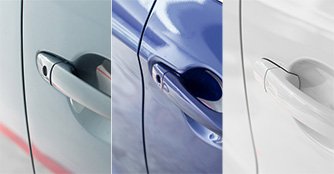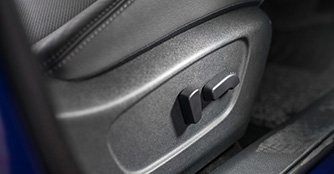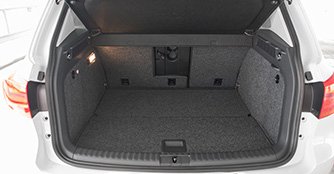CX-5 2.0 (A) vs Qashqai 2.0 Premium (A) vs Tiguan 1.4 TSI (A)
01 Sep 2014|73,701 views
Roomy and comfortable, versatile yet affordable, manoeuverable and increasingly fuel efficient, compact crossovers are becoming the talk of the town. These cars can easily ferry kids to school, bring groceries home, and still provide enough space for a weekend getaway.
The Mazda CX-5 made a slightly late foray into the crossover market in 2012, but it was Mazda's first vehicle to employ the full suite of innovative SkyActiv technologies, and also the first Mazda to feature the brand's new design language - 'KODO: Soul Of Motion', allowing it to gain popularity really fast.
The Nissan Qashqai is something of an old timer, part of the early crossover craze back in 2007. While the first generation of the compact crossover came with both a five-seater and a seven-seater variant (conveniently called the Qashqai+2) in Singapore and had achieved decent recognition, Nissan isn't willing to rest on its laurels and recently introduced the new Qashqai with five seats only.
Similarly, Volkswagen launched the Tiguan in 2007, matching the appeal of the Mk6 Golf hatchback it is based on with the versatility of an SUV. The German compact crossover went on to receive a facelift in 2011 as well as a performance tweak earlier this year, which brought it in line with the rest of Volkswagen's lineup.
Exterior
Headlining Mazda's new design language, the CX-5 showcases the brand's modern styling efforts with sculptured lines that strongly emphasise its powerful athletic cues.
The CX-5 also looks the largest in this comparison and this is proven by its dimensions of 4,540mm x 1,840mm x 1,670mm (L x W x H). This allows the CX-5 to have the most commanding road presence of the trio.
 |
'Sophisticated' and 'stylish' are words that best describe the revamped Qashqai. The car keeps up with the rest of the competition, sporting contemporary looks that are steps up from its predecessor. The car is also beefier and larger than before, growing 50mm longer and 23mm wider.
Additionally, the Qashqai sits 16mm lower than before, allowing it to have a sportier stance. This is enhanced by the huge 19-inch wheels that come standard only on the Qashqai in this shootout.
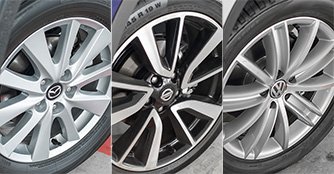
Based on the Mk6 Golf, the Tiguan may be one of the older crossovers but Volkswagen has kept it simple with its crisp lines, which has paid off in terms of appeal.
The Tiguan also looks a tad taller and narrower among the three cars, but it is lifted in the aesthetics department by neat detailing such as chrome lining and a purposeful stance. Comparing it to the Qashqai and the CX-5, the Tiguan comes across as being the matured one.
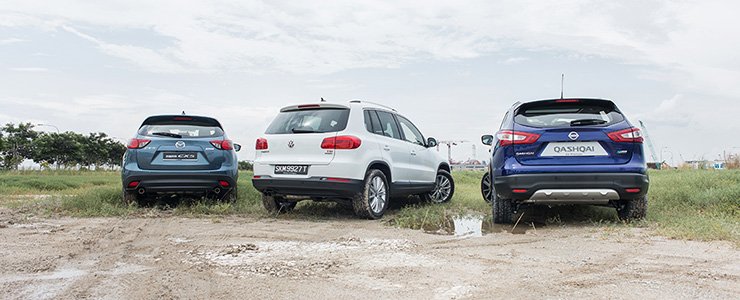 |
Interior
Unlike its exterior, the CX-5 features a simpler cabin layout that may come across as a little dull on first glance. Providing the visual treat then are the aluminium and piano black lacquer trim highlights, complemented with soft-touch surfaces, which help to add a tinge of class to the cabin.
Being the largest car in this comparison, the CX-5 is the most spacious for rear passengers, although there is a little bit of compromise on its 403-litre cargo capacity.
On the other hand, the new Qashqai has a totally revamped interior. Its cabin looks and feels far classier and upmarket than that of the outgoing model. The soft leather seats in the Qashqai also feel the most supportive, thanks to being zero-gravity inspired, like those found in the Note and the Teana.
Space wise, the Qashqai has sufficient head and legroom for all occupants. It also comes with a rather generous boot space of 430 litres.
In comparison, the Tiguan's cabin has a slightly dated design. But that's not to say it isn't a nice place to spend time in.
The Tiguan's interior has a simple and neat layout with dials and controls easily within reach of the driver, and it is lined with soft-touch leather, rubber and solid plastics of higher quality that give you peace of mind.
There's decent room at the back but when it comes to boot size the cavernous Volkswagen takes the honours, serving up a healthy 470 litres.
 |
The Drive
The CX-5 is rather perky on the go, thanks to its 2.0-litre SkyActiv engine that is paired with a six-speed automatic transmission. Off the line, the powerplant is eager to lug the 1.4-tonne vehicle along, going from 0 to 100km/h in a respectable 9.5 seconds.
During our test run, the CX-5 returned an impressive fuel economy of 12.8km/L, despite us prodding our heavy foot on the accelerator. The CX-5 is quite a gem in the handling department too. Regardless of its size, the CX-5 feels nimble and will respond with accuracy and confidence.
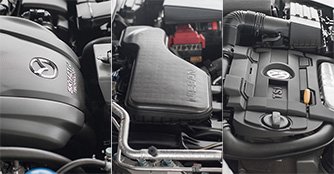
In comparison, the Qashqai does well on the move and is also the most refined but it is not one to be rushed. As a result, it takes 10.1 seconds for the Qashqai to go from nought to 100km/h.
Powered by a new 2.0-litre engine mated to an Xtronic CVT transmission, it may be a little harsh when pushed hard. But once you get the Qashqai up to speed, you will be rewarded with composure.
The CVT transmission also helps in fuel efficiency, and we managed to achieve a decent 11.5km/L with the Qashqai. While the Qashqai may not be as adept in tackling corners, with slight body roll experienced, it does offer the most comfortable ride for its occupants.
On the other hand, the Tiguan is the most energetic one of the trio, thanks to the way power is delivered via the 1.4-litre TSI engine that is wonderfully paired with a six-speed DSG transmission. The engine is punchy, albeit with a little bit of turbo lag. Notably, the gearbox will deliver smooth cogs along the way, allowing the Tiguan to reach the century mark in 8.9 seconds.
Having the smaller-sized powerplant equates to fuel savings too and the Tiguan returned an excellent 12km/L during the time spent with it. The Tiguan is a rather fun car to throw around too and it behaves very much like a smaller car, thanks in part to its Golf underpinnings.
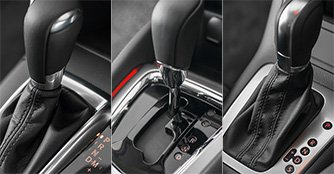
Conclusion
We like the way the CX-5 looks and the space it offers inside. The Mazda is also an attractive choice thanks to its engaging driving experience, efficiency and its rather competitive price of $146,800 (as of 21st August 2014).
With its grown-up looks and strong refinement, the new Qashqai certainly captivates. It may not have a lot of driving character, but a lengthy features list and classy cabin more than make up for it. And at $145,800 (as of 21st August 2014), the Qashqai costs the least among the trio.
The Tiguan is a handsome and neatly groomed crossover that has a small heart but zesty acceleration. And while it's the priciest, costing $18,500 over the Qashqai, it is superbly packaged with a high-quality cabin and sound dynamics.
After driving these cars back to back, it is the Qashqai that finishes in front by a nose. It is a remarkably well thought out and executed piece of design and engineering that you cannot help but to be impressed. Not forgetting being swayed by its attractive price too.
Roomy and comfortable, versatile yet affordable, manoeuverable and increasingly fuel efficient, compact crossovers are becoming the talk of the town. These cars can easily ferry kids to school, bring groceries home, and still provide enough space for a weekend getaway.
The Mazda CX-5 made a slightly late foray into the crossover market in 2012, but it was Mazda's first vehicle to employ the full suite of innovative SkyActiv technologies, and also the first Mazda to feature the brand's new design language - 'KODO: Soul Of Motion', allowing it to gain popularity really fast.
The Nissan Qashqai is something of an old timer, part of the early crossover craze back in 2007. While the first generation of the compact crossover came with both a five-seater and a seven-seater variant (conveniently called the Qashqai+2) in Singapore and had achieved decent recognition, Nissan isn't willing to rest on its laurels and recently introduced the new Qashqai with five seats only.
Similarly, Volkswagen launched the Tiguan in 2007, matching the appeal of the Mk6 Golf hatchback it is based on with the versatility of an SUV. The German compact crossover went on to receive a facelift in 2011 as well as a performance tweak earlier this year, which brought it in line with the rest of Volkswagen's lineup.
Exterior
Headlining Mazda's new design language, the CX-5 showcases the brand's modern styling efforts with sculptured lines that strongly emphasise its powerful athletic cues.
The CX-5 also looks the largest in this comparison and this is proven by its dimensions of 4,540mm x 1,840mm x 1,670mm (L x W x H). This allows the CX-5 to have the most commanding road presence of the trio.
'Sophisticated' and 'stylish' are words that best describe the revamped Qashqai. The car keeps up with the rest of the competition, sporting contemporary looks that are steps up from its predecessor. The car is also beefier and larger than before, growing 50mm longer and 23mm wider.
Additionally, the Qashqai sits 16mm lower than before, allowing it to have a sportier stance. This is enhanced by the huge 19-inch wheels that come standard only on the Qashqai in this shootout.
Based on the Mk6 Golf, the Tiguan may be one of the older crossovers but Volkswagen has kept it simple with its crisp lines, which has paid off in terms of appeal.
The Tiguan also looks a tad taller and narrower among the three cars, but it is lifted in the aesthetics department by neat detailing such as chrome lining and a purposeful stance. Comparing it to the Qashqai and the CX-5, the Tiguan comes across as being the matured one.
Interior
Unlike its exterior, the CX-5 features a simpler cabin layout that may come across as a little dull on first glance. Providing the visual treat then are the aluminium and piano black lacquer trim highlights, complemented with soft-touch surfaces, which help to add a tinge of class to the cabin.
Being the largest car in this comparison, the CX-5 is the most spacious for rear passengers, although there is a little bit of compromise on its 403-litre cargo capacity.
On the other hand, the new Qashqai has a totally revamped interior. Its cabin looks and feels far classier and upmarket than that of the outgoing model. The soft leather seats in the Qashqai also feel the most supportive, thanks to being zero-gravity inspired, like those found in the Note and the Teana.
Unlike its exterior, the CX-5 features a simpler cabin layout that may come across as a little dull on first glance. Providing the visual treat then are the aluminium and piano black lacquer trim highlights, complemented with soft-touch surfaces, which help to add a tinge of class to the cabin.
Being the largest car in this comparison, the CX-5 is the most spacious for rear passengers, although there is a little bit of compromise on its 403-litre cargo capacity.
On the other hand, the new Qashqai has a totally revamped interior. Its cabin looks and feels far classier and upmarket than that of the outgoing model. The soft leather seats in the Qashqai also feel the most supportive, thanks to being zero-gravity inspired, like those found in the Note and the Teana.
Space wise, the Qashqai has sufficient head and legroom for all occupants. It also comes with a rather generous boot space of 430 litres.
In comparison, the Tiguan's cabin has a slightly dated design. But that's not to say it isn't a nice place to spend time in.
The Tiguan's interior has a simple and neat layout with dials and controls easily within reach of the driver, and it is lined with soft-touch leather, rubber and solid plastics of higher quality that give you peace of mind.
There's decent room at the back but when it comes to boot size the cavernous Volkswagen takes the honours, serving up a healthy 470 litres.
The Drive
The CX-5 is rather perky on the go, thanks to its 2.0-litre SkyActiv engine that is paired with a six-speed automatic transmission. Off the line, the powerplant is eager to lug the 1.4-tonne vehicle along, going from 0 to 100km/h in a respectable 9.5 seconds.
During our test run, the CX-5 returned an impressive fuel economy of 12.8km/L, despite us prodding our heavy foot on the accelerator. The CX-5 is quite a gem in the handling department too. Regardless of its size, the CX-5 feels nimble and will respond with accuracy and confidence.
In comparison, the Qashqai does well on the move and is also the most refined but it is not one to be rushed. As a result, it takes 10.1 seconds for the Qashqai to go from nought to 100km/h.
Powered by a new 2.0-litre engine mated to an Xtronic CVT transmission, it may be a little harsh when pushed hard. But once you get the Qashqai up to speed, you will be rewarded with composure.
The CVT transmission also helps in fuel efficiency, and we managed to achieve a decent 11.5km/L with the Qashqai. While the Qashqai may not be as adept in tackling corners, with slight body roll experienced, it does offer the most comfortable ride for its occupants.
On the other hand, the Tiguan is the most energetic one of the trio, thanks to the way power is delivered via the 1.4-litre TSI engine that is wonderfully paired with a six-speed DSG transmission. The engine is punchy, albeit with a little bit of turbo lag. Notably, the gearbox will deliver smooth cogs along the way, allowing the Tiguan to reach the century mark in 8.9 seconds.
The CX-5 is rather perky on the go, thanks to its 2.0-litre SkyActiv engine that is paired with a six-speed automatic transmission. Off the line, the powerplant is eager to lug the 1.4-tonne vehicle along, going from 0 to 100km/h in a respectable 9.5 seconds.
During our test run, the CX-5 returned an impressive fuel economy of 12.8km/L, despite us prodding our heavy foot on the accelerator. The CX-5 is quite a gem in the handling department too. Regardless of its size, the CX-5 feels nimble and will respond with accuracy and confidence.
In comparison, the Qashqai does well on the move and is also the most refined but it is not one to be rushed. As a result, it takes 10.1 seconds for the Qashqai to go from nought to 100km/h.
Powered by a new 2.0-litre engine mated to an Xtronic CVT transmission, it may be a little harsh when pushed hard. But once you get the Qashqai up to speed, you will be rewarded with composure.
The CVT transmission also helps in fuel efficiency, and we managed to achieve a decent 11.5km/L with the Qashqai. While the Qashqai may not be as adept in tackling corners, with slight body roll experienced, it does offer the most comfortable ride for its occupants.
On the other hand, the Tiguan is the most energetic one of the trio, thanks to the way power is delivered via the 1.4-litre TSI engine that is wonderfully paired with a six-speed DSG transmission. The engine is punchy, albeit with a little bit of turbo lag. Notably, the gearbox will deliver smooth cogs along the way, allowing the Tiguan to reach the century mark in 8.9 seconds.
Having the smaller-sized powerplant equates to fuel savings too and the Tiguan returned an excellent 12km/L during the time spent with it. The Tiguan is a rather fun car to throw around too and it behaves very much like a smaller car, thanks in part to its Golf underpinnings.
Conclusion
We like the way the CX-5 looks and the space it offers inside. The Mazda is also an attractive choice thanks to its engaging driving experience, efficiency and its rather competitive price of $146,800 (as of 21st August 2014).
With its grown-up looks and strong refinement, the new Qashqai certainly captivates. It may not have a lot of driving character, but a lengthy features list and classy cabin more than make up for it. And at $145,800 (as of 21st August 2014), the Qashqai costs the least among the trio.
The Tiguan is a handsome and neatly groomed crossover that has a small heart but zesty acceleration. And while it's the priciest, costing $18,500 over the Qashqai, it is superbly packaged with a high-quality cabin and sound dynamics.
After driving these cars back to back, it is the Qashqai that finishes in front by a nose. It is a remarkably well thought out and executed piece of design and engineering that you cannot help but to be impressed. Not forgetting being swayed by its attractive price too.
Car Information
Mazda CX-5 2.0 (A)
CAT B|Petrol|15.6km/L
Horsepower
121kW (162 bhp)
Torque
200 Nm
Acceleration
9.5sec (0-100km /hr)
This model is no longer being sold by local distributor
All Used Mazda CX-5Volkswagen Tiguan 1.4 TSI DSG (A)
CAT B|Petrol|14.1km/L
Horsepower
118kW (158 bhp)
Torque
240 Nm
Acceleration
8.9sec (0-100km /hr)
This model is no longer being sold by local distributor
All Used Volkswagen TiguanNissan Qashqai 2.0 Premium (A)
CAT B|Petrol|14.5km/L
Horsepower
106kW (142 bhp)
Torque
200 Nm
Acceleration
10.1sec (0-100km /hr)
This model is no longer being sold by local distributor
All Used Nissan QashqaiThank You For Your Subscription.
























































